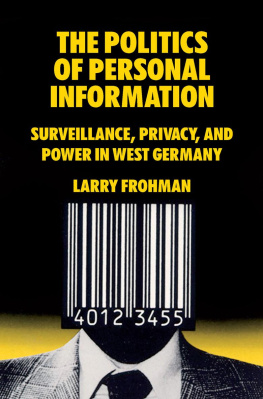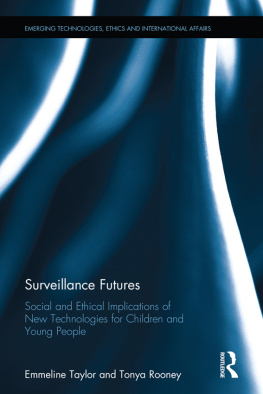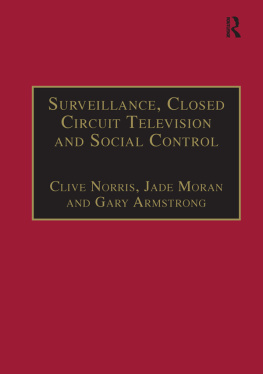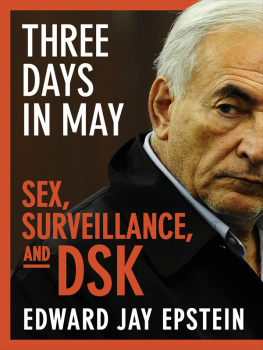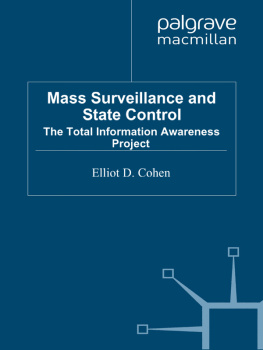CCTV
CCTV
A Technology Under the Radar?
INGA KROENER
Trilateral Research and Consulting, UK
First published 2014 by Ashgate Publishing
Published 2016 by Routledge
2 Park Square, Milton Park, Abingdon, Oxon OX14 4RN
711 Third Avenue, New York, NY 10017, USA
Routledge is an imprint of the Taylor & Francis Group, an informa business
Copyright Inga Kroener 2014
Inga Kroener has asserted her right under the Copyright, Designs and Patents Act, 1988, to be identified as the author of this work.
All rights reserved. No part of this publication may be reproduced, stored in a retrieval system or transmitted in any form or by any means, electronic, mechanical, photocopying, recording or otherwise without the prior permission of the publisher.
Notices:
Product or corporate names may be trademarks or registered trademarks, and are used only for identification and explanation without intent to infringe.
British Library Cataloguing in Publication Data
A catalogue record for this book is available from the British Library
The Library of Congress has cataloged the printed edition as follows:
Kroener, Inga.
CCTV : a technology under the radar? / by Inga Kroener.
pages cm
Includes bibliographical references and index.
ISBN 978-1-4094-2345-4 (hardback) 1. Crime prevention--Social aspects--Great Britain-- History. 2. Video surveillance--Great Britain--History. 3. National security--Great Britain--History. 4. Privacy, Right of--Great Britain--History. I. Title.
HV7434.G7.K76 2014
364.4--dc23
2013045479
ISBN 9781409423454 (hbk)
Contents
Acknowledgements
I owe a huge thanks to a number of people for their help, advice and proof reading of various chapters: Jon Agar, Chris Williams, Chris Newstead, Kieron Flanagan, Lisa Southern, and Daniel Neyland. Thank you so much for giving up your time. A big thank you as well to Claire Jarvis and Gemma Hayman at Ashgate for their help throughout this book writing process.
To all the people who participated in the questionnaire and interviews thank you.
And to my friends and family thank you for your continuous encouragement throughout this process. I also need to include a special thank you to James for his unwavering support.
This book is dedicated to my parents. For everything you have done for me.
List of Abbreviations
ACPO | Association of Chief Police Officers |
ANPR | Automatic Number Plate Recognition |
CCTV | Closed circuit television |
DHS | Department of Homeland Security |
DPA | Data Protection Act 1998 |
Nacro | National Association for the Care and Resettlement of Offenders |
RIPA | Regulation of Investigatory Powers Act 2000 |
STS | Science and Technology Studies |
Introduction
In 1991, in a seminal paper published in Scientific American, Mark Weiser made the following statement: the most profound technologies are those that disappear. They weave themselves into the fabric of everyday life until they are almost indistinguishable from it. He was referring to computers, but perhaps this statement resonates particularly with CCTV and its widespread use in Britain. Why has Britain become so camera-surveilled? What were the factors involved in its development and subsequent use as a technology to protect people from crime? How has a seemingly mundane technology become such an important tool for politicians and the police? And how did the widespread deployment of a surveillance technology occur seemingly under the radar of the public?
A number of academics and other commentators have raised concerns over Britains entry into a surveillance society in recent years (see for example, Lyon 2001). There has undoubtedly been an increase in the amount of information collected, stored and processed on the British population over recent years, but whether this means we now live in a surveillance society is debatable. Surveillance practices and technologies certainly form a part of our society, but the line over which we theoretically cross into a surveillance society is an arbitrary one.
Nonetheless, this increase in surveillance activities, technologies, and actions has prompted a burgeoning literature focusing on power relations (Lyon 2007), social sorting (Lyon 2003), classification (Haggerty and Ericson 2006), social order (Rule 1973), the Panopticon (Poster 1990), and networks and categories (Marx 2002), to name a few aspects. What this literature tells us is that surveillance is a complex issue, tied together with notions of identity, discipline, power, social sorting, and categorisation. It also shows us that there are a variety of approaches to studying surveillance. In all of these studies there is an underlying message that surveillance is widespread and endemic. However, as Rule has argued, surveillance practices are also constrained in terms of their size and the amount of information they can process. They are not absolutes. The existence of a variety of surveillance systems and practices does not necessarily herald our entry into a surveillance society.
CCTV
In the context of thinking about CCTV (which is the main focus of this book) this notion that we have entered into a surveillance society becomes an important one. If CCTV is assumed to simply be part of this surveillance society then there is little left to question in terms of its history. It becomes part of an inevitable evolution of a society into one that is based primarily on surveillance practices. Even the popular claim that there are over 4.2 million CCTV cameras in Britain (which, although disputed, still appears in some recent academic literature and media reports) implies that there is nothing left to resist or question. There is a question that needs to be addressed, however. Why has Britain become so camera-surveilled?
There is a growing literature concerned with CCTV. CCTV is heralded as expanding disciplinary social control as well as targeting individuals in terms of suspicious behaviour (see for example, Norris 2003). Risk and security have also become important themes within research. Norris and Armstrong (1999) argue that systems of surveillance are ushered in by motifs of the stranger society in relation to a loss of communication and community. This loss of communication leads to less knowledge of others actions and a reduced ability to predict others behaviour, in turn leading to an increased sense of risk and fear. Camera systems are then used to manage these feelings of risk and fear, although it can be argued that they may actually have the opposite effect (Kroener and Neyland 2012).
Other literatures concentrate on public space and the impact of CCTV on this space, often bound with issues related to social control, including the Panopticon, exclusion, discrimination and consumption. The use of CCTV in public space is discussed in relation to a fortification of the city, which arises from a sense of danger and feelings of fear, developed through interactions with strangers (Fyfe, Bannister, and Kearns 1998). These new forms of social interaction are also said to have led to new forms of social control where the city has become a place to manage out inappropriate behaviour in the new territories of consumption (McCahill 1998). Some now suggest that civil space has become consumer space, with a control of public space in the town centre where certain types of behaviour are not accepted (Reeve 1998). These literatures all suggest that cities have become Panopticons through the use of CCTV (Ainley 1998; Cohen 1985; Davis 1990; Lyon 1994; Oc and Tiesdell 1997). Furthermore, Koskela (2000) suggests that video surveillance changes the way power is exercised and modifies emotional experiences in urban spaces, as well as affecting the way in which reality is conceptualised and understood. In this sense then, Koskela (2000, p.243) argues that CCTV and surveillance contributes to the production of urban space.


